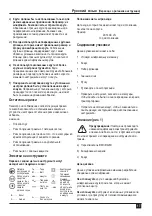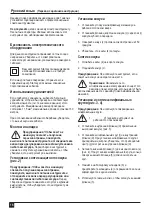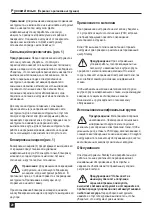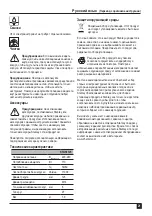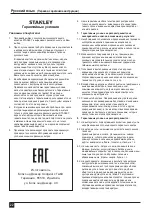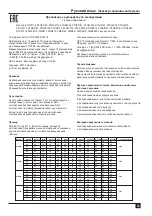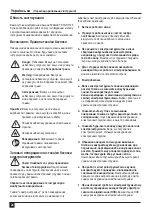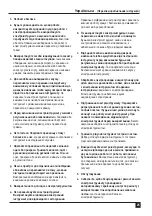
2. Keep the edge of the wheel tilted at angle from 15 to 30
degrees against the surface of the workpiece.
3. When using a new grinding wheel, do not operate the
wheel in the B direction, otherwise, it will cut into the
workpiece. When the edge of wheel has been rounded
off, you are free to operate the grinder in either the A or B
direction.
Starting and Stopping (Fig. 1)
Warning:
Before using the tool, check whether
the handle is tightened securely. Check whether
the ON/OFF switch is working normally.
Before plugging in the tool to the power supply, check
whether the switch is in the OFF (o) position when pressing
the rear end of the switch.
To start the tool, press the rear end of the switch and slide it
forward. Then press the front end of the switch to lock it.
Press the rear end of the switch to stop the tool.
Warning:
Do not switch the tool on or off while
under load conditions.
Proper Hand Position (Fig. 6)
Warning:
To reduce the risk of serious personal
injury, ALWAYS use proper hand position as
shown.
Warning:
To reduce the risk of serious personal
injury, ALWAYS hold securely in anticipation of a
sudden reaction.
Proper hand position requires one hand on the side handle
(figure 1), with the other hand on the body of the tool, as
shown in figure 6.
Switches
Caution:
Hold the body of the tool firmly to
maintain control of the tool at start up and during
use and until the wheel or accessory stops
rotating. Make sure the wheel has come to a
complete stop be fore laying the tool down.
Note:
To reduce unexpected tool movement, do not switch
the tool on or off while under load conditions. Allow the
grinder to run up to full speed before touching the work
surface. Lift the tool from the surface before turning the tool
off. Allow the tool to stop rotating before putting it down.
Slider switch (Fig. 1)
Warning:
Before connecting the tool to a power supply, be
sure the slider switch is in the off position by pressing the
rear part of the switch and releasing. Ensure the slider
switch is in the off position as described above after any
interruption in power supply to the tool, such as the
activation of a ground fault interrupter, throwing of a circuit
breaker, accidental unplugging, or power failure. If the slider
switch is locked on when the power is connected, the tool
will start unexpectedly..
To start the tool, slide the slider switch (a) toward the front of
the tool. To stop the tool, release the slider switch.For
continuous operation, slide the switch toward the front of the
tool and press the forward part of the switch inward. To stop
the tool while operating in continuous mode, press the rear
part of the slider switch and release.
Spindle lock (Fig. 1)
The spindle lock (b) prevents the output shaft from rotating
when attaching or removing the grinding wheel. Only use the
spindle lock when the tool is switched off, power is
unplugged, and wheel stops completely.
Note:
To minimize tool damages, don't use the
spindle lock when the tool is operating.
Otherwise, it may damage the tool. The attached
accessories may come off and cause injury.
If using the spindle lock, press the spindle lock button and
rotate the output shaft until it stops.
Application on Metals
When applying the tool on metals, make sure that a
residual-current device (RCD) is inserted to prevent danger
from metal chips.
If the RCD causes power disconnection, have the tool sent
to an authorized Stanley dealer for repair.
10
ENGLISH
(Original instructions)
Summary of Contents for STGS7125
Page 1: ...STGS7125 English Page 4 Русский Page 13 Українська Page 24 ...
Page 2: ...Figure 1 b c c d h f g e i k Figure 2 Figure 3 n a 2 ENGLISH Original instructions ...
Page 3: ...Figure 5 Figure 6 Figure 4 h f d e 15o 30o A B 3 Original instructions ENGLISH ...
Page 34: ......
Page 35: ......
Page 36: ...N472828 04 2016 ...

















